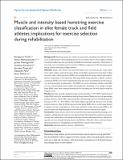Muscle and intensity based hamstring exercise classification in elite female track and field athletes: implications for exercise selection during rehabilitation
Author(s)
Malliaropoulos, Nikos; Panagiotis, Tsaklis; Jurdan, Mendiguchia; Vasilis, Korakakis; Debasish, Pyne; Peter, Malliaras; Tsapralis, Kyriakos; ... Show more Show less
DownloadTsaklis-2015-Muscle and intensity.pdf (3.518Mb)
PUBLISHER_CC
Publisher with Creative Commons License
Creative Commons Attribution
Terms of use
Metadata
Show full item recordAbstract
Background:
Hamstring injuries are common in many sports, including track and field. Strains occur in different parts of the hamstring muscle but very little is known about whether common hamstring loading exercises specifically load different hamstring components. The purpose of this study was to investigate muscle activation of different components of the hamstring muscle during common hamstring loading exercises.
Methods:
Twenty elite female track and field athletes were recruited into this study, which had a single-sample, repeated-measures design. Each athlete performed ten hamstring loading exercises, and an electromyogram (EMG) was recorded from the biceps femoris and semitendinosus components of the hamstring. Hamstring EMG during maximal voluntary isometric contraction (MVIC) was used to normalize the mean data across ten repetitions of each exercise. An electrogoniometer synchronized to the EMG was used to determine whether peak EMG activity occurred during muscle-tendon unit lengthening, shortening, or no change in length. Mean EMG values were compared between the two recording sites for each exercise using the Student’s t-test.
Results:
The lunge, dead lift, and kettle swings were low intensity (<50% MVIC) and all showed higher EMG activity for semitendinosus than for biceps femoris. Bridge was low but approaching medium intensity, and the TRX, hamstring bridge, and hamstring curl were all medium intensity exercises (≥50% or <80% MVIC). The Nordic, fitball, and slide leg exercises were all high intensity exercises. Only the fitball exercise showed higher EMG activity in the biceps femoris compared with the semitendinosus. Only lunge and kettle swings showed peak EMG in the muscle-tendon unit lengthening phase and both these exercises involved faster speed.
Conclusion:
Some exercises selectively activated the lateral and medial distal hamstrings. Low, medium, and high intensity exercises were demonstrated. This information enables the clinician, strength and conditioning coach and physiotherapist to better understand intensity- and muscle-specific activation during hamstring muscle rehabilitation. Therefore, these results may help in designing progressive strengthening and rehabilitation and prevention programs.
Date issued
2015-06Department
Massachusetts Institute of Technology. Department of Mechanical EngineeringJournal
Open Access Journal of Sports Medicine
Publisher
Dove Medical Press
Citation
Malliaropoulos, Nikos, Tsaklis Panagiotis, Mendiguchia Jurdan, Korakakis Vasilis, Pyne Debasish, Malliaras Peter, and Kyriakos Tsapralis. “Muscle and Intensity Based Hamstring Exercise Classification in Elite Female Track and Field Athletes: Implications for Exercise Selection During Rehabilitation.” Open Access Journal of Sports Medicine (June 2015): 209.
Version: Final published version
ISSN
1179-1543